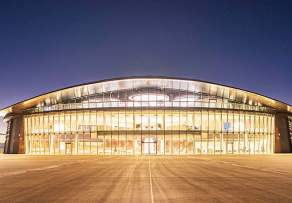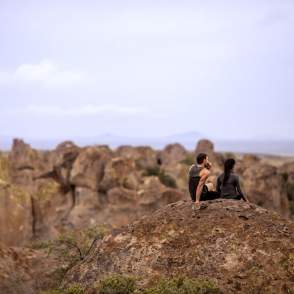Unlimited Skies In Las Cruces
Southern New Mexico has a long history with aerospace research, engineering, testing, and space exploration. The aerospace industry has always had a strong foothold throughout our state, and suborbital flights and space tourism will ensure that it always does. Over 60 aerospace companies currently have a presence in New Mexico, several which are NewSpace concepts. Las Cruces offers an excellent home-base for visitors to tour space museums, Spaceport America, and nearby space-related attractions.

The Birthplace Of America’s Missile And Space Program
Lying a few miles west of the Organ Mountains is a sign that welcomes visitors to White Sands Missile Range, the birthplace of America’s missile and space program. It’s an accolade that very few people know about but space, and the continued exploration of the Universe, has long been a strong influence on industry in the region and in particular, in Las Cruces. In fact, the very first image of Earth from space was taken on October 24th, 1946 by a rocket launched from White Sands Missile Range (WSMR). The German V2 Rocket, captured by America in WWII, reached an impressive 105 kms above the ground.
In the same year as the V2 rocket launch, renowned astronomer Clyde Tombaugh moved to Las Cruces to work on tracking telescopes used to photograph rockets and missiles during test flights. Tombaugh is widely known for his discovery of Pluto in 1930, but he also discovered other celestial bodies and developed instruments such as the IGOR (Intercept Ground Optical Recorder), which remained in use at WSMR for the next 30 years.
Tombaugh moved to the Physical Science Laboratory at New Mexico State University (NMSU) in 1955 to study ‘Near Earth Satellite Search’ which assured NASA that there were no natural satellites or debris that could interfere with sending rockets, and eventually humans, into space. Tombaugh taught at NMSU until his retirement in 1973 and continued to study the Universe from his backyard observatory in Mesilla until his death in 1997. His ashes were later sent to space on-board the New Horizons probe in 2006, destined for Pluto.

In 1963, NASA established the White Sands Test Facility (WSTF) in the western foothills of the Organ Mountains. The primary mission of the facility was the support NASA’s Space Station program and previously the Shuttle Program. Today WSTF primarily participates in propulsion systems testing and often their testing can be heard across Las Cruces in the Mesilla Valley.
50 miles southwest of Las Cruces lies a maar volcanic crater with ties to NASA’s Apollo Space Program. A maar crater is one that is broad and shallow, typically filled by a lake, formed by an eruption with little lava. Kilbourne Hole and its neighbor Hunt’s Hole were used by NASA to train Apollo Astronauts. NASA used the volcanic fields during exercises on how to observe pertinent geological features and collect samples that Astronauts later used during missions.
Apollo Astronauts that trained at Kilbourne Hole ahead of their missions:
- Apollo 12 Astronauts Charles “Pete” Conrad and Alan L. Bean and support crewman Edward Gibson trained at Kilbourne Hole in April 1969, ahead of their successful lunar landing in November of 1969
- Apollo 12 Richard Gordon
- Apollo 14 Alan Shepard and Edgar Mitchell
- Apollo 15 David Scott and James Irwin
- Apollo 16 John Young and Charlie Duke
- Apollo 17 Eugene Cernan and New Mexico’s Harrison “Jack” Schmitt

While Las Cruces and the surrounding region holds a prominent place in America’s space history, it also continues to gain international attention with the prospects of future space exploration. In 2006, construction began on the ‘World’s first commercial Spaceport’ north of Las Cruces.
A day at Spaceport America!
By Kirsten Rodgers Did you ever dream of going to space as a child? To float around without gravity…
Museums
The New Mexico Museum of Space History, a Smithsonian Affiliate museum, has been a New Mexico institution since 1976. Located in Alamogordo, New Mexico, the museum is just a short day trip from Las Cruces. It offers a variety of artifacts and displays related to aerospace, space flight and the space age, with a focus on New Mexico’s role in the U.S. manned space program. Highlights of your visit to the museum will include exhibits about the U.S. and international space programs, HAM the Astrochimp, the International Space Hall of Fame, large format films and planetarium shows screened daily in the New Horizons Theater, and the John P. Stapp Air and Space Park featuring the Little Joe II rocket – the largest rocket ever launched from New Mexico to date.
The museum is also the designated repository for Spaceport America and the National Space Society.
OFFICIAL SITE
Fun fact
Ham the first chimpanzee to go to space is buried at the museum grounds.

Space Tourism
Sightseeing Space
A trip to Las Cruces offers lots of open spaces, with one of the most enchanting being outer space. Southern New Mexico is full of space history, spanning from NASA test launches long before astronauts took flight and today’s Spaceport America, the world’s first purpose-built commercial spaceport to the discovery of Pluto and the first commercially manned Virgin Galactic spaceship flight.
Just a few of the must see for the proud space enthusiasts:
Space Murals Museum
The museum is abundant in donated relics from the space program, historic photographs and interesting and fact telling objects. Outside it houses a 1.2-million-gallon water tank with murals of the U.S. Space program history, a 1/8 scale replica of the Challenger Shuttle and several other artifacts.
OFFICIAL SITE
Tombaugh Observatory
Home to the custom-built telescope by Clyde Tombaugh, the discoverer of Pluto, which is still regarded as a planet in New Mexico, and operated by the Astronomic Society of Las Cruces. The group hosts several open houses throughout the year as well as viewing parties for celestial events.
OFFICIAL SITE
Spaceport America
The world’s first purpose-built commercial spaceport boasts a 12,000 by 200-foot runway, vertical launch complexes and tenants such as Virgin Galactic and SpinLaunch. It has been the site for numerous commercials and films as well as the home for the world’s largest intercollegiate rocket launch competition. The only way to visit the complex is on an authorized tour that leaves from Las Cruces, so make sure to book ahead.
OFFICAL SITE
Las Cruces Nature and Science Museum
MoNaS is designed to inspire curiosity and life-long learning and discovery of nature and science. The three permanent exhibits include Desert Life with live animal displays and feedings, Light and Space with interactive exhibits, and Permian Trackways with life-size replicas of the amazing discovery and dinosaur fossils.
OFFICIAL SITE
Sunspot Scenic Byway and National Solar Observatory
The 15-mile stretch begins near Cloudcroft, New Mexico and ends at the Sunspot Visitor Center and Observatory. Follow the signs representing planets and you won’t be able to lose your way. Upon arrival, enjoy the interactive exhibits, and next to the observatory currently operated by New Mexico State University. Take a self-guided tour of the grounds, making sure to stop at the lookout peak for an amazing view of White Sands National Park.
OFFICIAL SITE
Starry Nights
Star Gazing Spots
Southern New Mexico’s dark sky is ideal for stargazers. In fact, the state’s sky is protected under the Night Sky Protection Act, enacted in 1999. Its purpose is to regulate outdoor lighting to ensure the sky remains dark for wildlife, viewing, research and educational purposes, and to conserve energy. The Astronomical Society of Las Cruces names the following locations as “Dark Sky Sites” for star gazing:
- Leasburg Dam State Park- 16 miles north of Las Cruces via Interstate 25 or New Mexico Highway 185
- Yost Escarpment- 49 north of Las Cruces via Interstate 25 and Upham Exit 32 to County Road E-070
- Corralitos Road- 15 miles west of Las Cruces via Interstate 10 and Exit 132
- Akela Area- 33 mile west of Las Cruces via Interstate 10 and Exit 116 to County Road C001
OFFICIAL SITE
 The Las Cruces Space Festival
The Las Cruces Space Festival
The Las Cruces Space Festival is an annual celebration of space-related activity and interest in southern New Mexico and beyond. The mission: Making Space for Everyone
Many partner organizations across the community are involved–ranging from the public schools, local universities and colleges, space industry, the City of Las Cruces, arts and cultural groups, and many others–to provide an event for people of all ages and interests.
The festival aims to raise awareness and celebrate space-related activity and achievements in the region–past, present and future–by providing an event where people can have fun, learn about new possibilities, and get inspired and excited by the various elements of the week-long festival.
The festival is free to participate in, and open to all, with the cost of activities, presentations, displays and exhibits all covered by generous local sponsorships. The Las Cruces Space Festival celebrates ‘space’ – it is an annual event to recognize space-related activity and interest in southern New Mexico and beyond.
- Raise Awareness in our Community and beyond of space-related activity in the region – past, present and future
- Educate and Inspire our Youth (all ages)
- Celebrate the Anniversary of Human Spaceflight (April 12th – “Yuri’s Night”)
- Provide Entertainment and Fun for Participants
- Provide / Enable Economic Impact in Doña Ana & Sierra counties
- Support development and needs of a sustainable Spaceport












